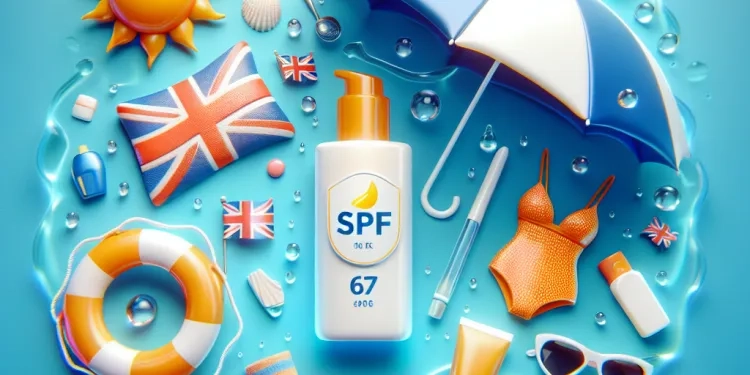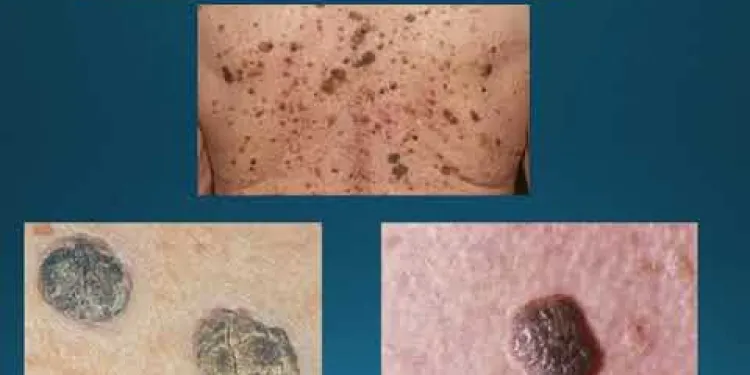
Find Help
More Items From Ergsy search
-

What's the difference between chemical and physical sunscreens?
Relevance: 100%
-

Can I use expired sunscreen?
Relevance: 63%
-

Does sunscreen expire?
Relevance: 63%
-

Which factor sunscreen should I use?
Relevance: 60%
-

Can makeup with SPF replace sunscreen?
Relevance: 59%
-

Do I need sunscreen on cloudy days?
Relevance: 59%
-

How often should I reapply sunscreen?
Relevance: 56%
-

Which sunscreen should I use?
Relevance: 47%
-

How does sunscreen with SPF 20 compare to SPF 50?
Relevance: 46%
-

What SPF should I use if I have sensitive skin?
Relevance: 40%
-

Should I use a different SPF for my face and body?
Relevance: 29%
-

Is a higher SPF always better?
Relevance: 28%
-

Do I need a different SPF for water-related activities?
Relevance: 28%
-

What SPF should I use if I am going to be outdoors all day?
Relevance: 28%
-

What SPF level is recommended to prevent sunburn?
Relevance: 27%
-

Does tanning lotion prevent sunburn?
Relevance: 27%
-

What does SPF stand for?
Relevance: 27%
-

Is there a sunscreen that protects against all UV radiation?
Relevance: 26%
-

Can sunburn be prevented?
Relevance: 25%
-

How can I be sure that my sunscreen SPF rating is accurate?
Relevance: 23%
-

Self care - sunburn
Relevance: 22%
-

Can dark-skinned individuals get sunburned?
Relevance: 22%
-

What are UVA and UVB rays?
Relevance: 21%
-

Is it possible to be allergic to the sun?
Relevance: 21%
-

At what time of day is the sunburn risk highest?
Relevance: 19%
-

What should I wear during a heatwave?
Relevance: 19%
-

What to do if you're sunburnt
Relevance: 19%
-

What is sunburn?
Relevance: 19%
-

How can I keep children safe during a heatwave?
Relevance: 18%
-

Will I be able to engage in physical exercise?
Relevance: 18%
-

Skin cancer education
Relevance: 18%
-

Can physical symptoms be linked to relationship-induced depression?
Relevance: 17%
-

Will I need physical therapy after a hip replacement?
Relevance: 17%
-

How important is physical activity in preventing obesity?
Relevance: 17%
-

Is the physical card still valid after 2025?
Relevance: 17%
-

Why do some people not burn as easily as others?
Relevance: 17%
-

Can physical exertion trigger a heart attack?
Relevance: 17%
-

Will the digital driving license replace the physical card?
Relevance: 16%
-

Does physical exercise help people with CFS?
Relevance: 16%
-

How can I keep my kids cool during a heatwave?
Relevance: 16%
Understanding Sunscreens: Chemical vs. Physical
Sunscreens are essential in helping protect our skin from the harmful effects of ultraviolet (UV) radiation. They are broadly classified into two categories: chemical and physical sunscreens. Understanding the difference between the two can help you make more informed decisions about sun protection, especially given the varying weather conditions across the UK.
Chemical Sunscreens
Chemical sunscreens work by absorbing UV rays and transforming them into heat, which is then released from the skin. These sunscreens contain organic compounds, such as oxybenzone, avobenzone, octisalate, octocrylene, homosalate, and octinoxate. When applied, they absorb UV radiation and prevent it from penetrating the deeper layers of the skin.
One of the advantages of chemical sunscreens is their typically lighter formulation, making them preferable for everyday use, especially under makeup. They tend to be less visible on the skin as they absorb more easily. However, they require about 20 minutes after application to become effective, requiring a waiting period before sun exposure.
There are some considerations to bear in mind with chemical sunscreens. Some individuals with sensitive skin may find them irritating. Additionally, certain ingredients in chemical sunscreens have raised environmental concerns, particularly in relation to coral reefs.
Physical Sunscreens
Physical sunscreens, also known as mineral sunscreens, use mineral-based ingredients such as zinc oxide and titanium dioxide. These minerals create a barrier on the skin’s surface which reflects and scatters UV radiation away from the skin. This provides immediate protection against both UVA and UVB rays after application.
Physical sunscreens are an excellent choice for those with sensitive skin or conditions like rosacea, as they are generally less irritating. They also tend to last longer in direct UV exposure, although they can be more prone to rubbing off and may require frequent reapplication, particularly if you are sweating or swimming.
One downside is that physical sunscreens can sometimes leave a whitish cast on the skin, particularly noticeable on darker skin tones. Recent formulations, however, have improved this with micronized particles that are less visible.
Choosing the Right Sunscreen
When deciding between chemical and physical sunscreens, consider factors such as your skin type, the environment you'll be in, and any personal preference for texture or formula. In the UK, where the sun may not always be intense, the choice often depends on skin sensitivity and daily activity levels.
Ultimately, the most crucial aspect is that you use some form of sunscreen regularly, with a broad-spectrum protection of at least SPF 30. Reapplication throughout the day, especially during outdoor activities, is essential to ensure continued protection.
Understanding Sunscreens: Chemical vs. Physical
Sunscreens help protect our skin from the sun. There are two main types: chemical and physical sunscreens. Knowing how they work can help you pick the right one, especially with changing weather in the UK.
Chemical Sunscreens
Chemical sunscreens soak up the sun's rays and turn them into heat. This heat then leaves your skin. They have special ingredients like oxybenzone and avobenzone. These sunscreens stop the sun's rays from going deep into your skin.
Chemical sunscreens are often lightweight and good for everyday use, even under makeup. They are not very noticeable on the skin. But, you have to wait about 20 minutes after putting them on before they work.
Some people with sensitive skin might find chemical sunscreens irritating. Also, some ingredients can harm the environment, especially coral reefs.
Physical Sunscreens
Physical sunscreens, also called mineral sunscreens, have minerals like zinc oxide and titanium dioxide. These minerals make a shield on your skin that bounces the sun’s rays away. They protect you as soon as you put them on.
These sunscreens are good for people with sensitive skin or conditions like rosacea. They stay longer under the sun but can rub off, especially if you're sweating or swimming, so you may need to reapply them often.
Sometimes, physical sunscreens leave a white mark on your skin, which can show on darker skin tones. Newer ones are better and less visible.
Choosing the Right Sunscreen
Think about your skin type, where you'll be, and if you like a certain feel when choosing between chemical and physical sunscreens. In the UK, even if the sun isn't too strong, pick based on your skin sensitivity and daily activities.
The most important thing is to use a sunscreen regularly. Look for one with at least SPF 30 that protects against all sun rays. Remember to put it on again during the day, especially if you're outside.
Frequently Asked Questions
What are chemical sunscreens?
Chemical sunscreens contain organic compounds that absorb UV radiation and convert it into heat, which is then released from the skin.
What are physical sunscreens?
Physical sunscreens, also known as mineral sunscreens, contain active mineral ingredients like titanium dioxide or zinc oxide, which sit on top of the skin and reflect or scatter UV radiation.
How do chemical sunscreens work?
Chemical sunscreens absorb UV radiation through their chemical ingredients and transform it into harmless heat, which is then dissipated from the skin.
How do physical sunscreens work?
Physical sunscreens create a barrier on the skin's surface that reflects and scatters UV radiation, preventing it from penetrating the skin.
Are chemical sunscreens immediately effective upon application?
No, chemical sunscreens typically require about 15 to 30 minutes to form a protective film on the skin and become effective.
Are physical sunscreens immediately effective upon application?
Yes, physical sunscreens are effective immediately upon application because they sit on the skin's surface.
Do chemical sunscreens offer broad-spectrum protection?
Yes, many chemical sunscreens offer broad-spectrum protection, but it depends on the combination of ingredients used. It is important to check the label.
Do physical sunscreens offer broad-spectrum protection?
Yes, physical sunscreens naturally provide broad-spectrum protection as titanium dioxide and zinc oxide protect against both UVA and UVB rays.
Are chemical sunscreens suitable for sensitive skin?
Some individuals with sensitive skin may experience irritation or allergic reactions with chemical sunscreens, so it's important to patch test and choose formulations free from irritating additives.
Are physical sunscreens suitable for sensitive skin?
Yes, physical sunscreens are often recommended for sensitive skin types due to their gentle, non-irritating formulas.
What are common ingredients in chemical sunscreens?
Common ingredients in chemical sunscreens include oxybenzone, avobenzone, octisalate, octocrylene, homosalate, and octinoxate.
What are common ingredients in physical sunscreens?
The most common ingredients in physical sunscreens are zinc oxide and titanium dioxide.
Do chemical sunscreens feel heavy or greasy on the skin?
Chemical sunscreens generally have a lighter, more fluid texture that is absorbed into the skin, which many people prefer for daily use under makeup.
Do physical sunscreens leave a white cast on the skin?
Physical sunscreens can leave a white cast, especially on darker skin tones, due to the presence of mineral particles, but tinted or micronized formulations can help reduce this effect.
Which is better for acne-prone skin: chemical or physical sunscreen?
Physical sunscreens are often recommended for acne-prone skin as they are less likely to clog pores and typically contain fewer irritants.
Can chemical sunscreens cause allergic reactions?
Yes, some people may experience allergic reactions or skin irritation from certain chemical sunscreen ingredients. If you have sensitive skin, it's important to test new sunscreen formulas carefully.
Do physical sunscreens need frequent reapplication?
All sunscreens, including physical ones, require reapplication every two hours or immediately after swimming, sweating, or towel drying for optimal protection.
Are chemical sunscreens more water-resistant than physical sunscreens?
Water resistance varies by product rather than type. Both chemical and physical sunscreens can be formulated to be water-resistant, so it's important to check the label for specific claims.
Is any one type of sunscreen considered safer for the environment?
Physical (mineral) sunscreens are typically considered more environmentally friendly, as some chemical sunscreen ingredients have been shown to harm coral reefs.
Can I layer chemical and physical sunscreens for better protection?
Yes, you can layer both types, but it's crucial to ensure that they are compatible with each other for effective protection. Usually, applying physical sunscreen first is recommended.
What is chemical sunscreen?
Chemical sunscreen is a type of cream or lotion that helps protect your skin from the sun. It has special chemicals that soak up the sun's rays so they don’t harm your skin.
Helpful Tip: Use pictures or videos to see how to apply sunscreen. You can also ask someone to help you put it on!
Chemical sunscreens have special stuff in them. This special stuff takes in the sun's rays and turns them into heat. Then, the heat leaves your skin.
What are physical sunscreens?
Physical sunscreens are creams or lotions. They protect your skin from the sun. They have tiny minerals in them. These minerals sit on top of your skin. They block the sun's rays like a shield.
If the words are hard to understand, you can ask someone to explain. You can also look at pictures or watch videos to learn more.
Physical sunscreens, called mineral sunscreens, have special ingredients like titanium dioxide or zinc oxide. These ingredients stay on your skin's surface and help bounce away the sun's rays.
If you find reading tricky, using a ruler to guide your eyes or reading out loud can help.
How do chemical sunscreens work?
Chemical sunscreens help keep your skin safe from the sun. They have special stuff that soaks up the sun's bad rays. This helps stop sunburns and keeps your skin safe.
If you find reading hard, use pictures or ask someone for help. You can also listen to the information with text-to-speech tools.
Chemical sunscreens help protect your skin from the sun. They use special ingredients to soak up the sun's rays and turn them into heat. This heat then safely leaves your skin.
How do physical sunscreens work?
Sunscreen helps stop the sun from hurting your skin.
Physical sunscreen is a special cream that you put on. It works like a shield on your skin.
It uses tiny minerals called zinc oxide or titanium dioxide. These minerals sit on top of your skin.
When the sun shines, these minerals bounce the sun's rays away. This keeps your skin safe from getting burned.
If you need help putting on sunscreen, ask an adult. Remember to wear a hat and sunglasses too!
Physical sunscreens make a shield on your skin. This shield bounces away the sun's rays. It stops the sun from getting into your skin.
Do chemical sunscreens work right after you put them on?
No, chemical sunscreens need about 15 to 30 minutes to start working on your skin.
Do Physical Sunscreens Work Right After You Put Them On?
Do you want to know if physical sunscreens start working as soon as you put them on your skin? Physical sunscreens are creams that protect your skin from the sun. They have special stuff like zinc oxide or titanium dioxide.
When you use physical sunscreen, it works right away. As soon as you put it on, it can help protect your skin from the sun's rays.
If you need help putting on sunscreen, you can ask someone to help you. It is a good idea to keep your sunscreen where you can see it so you remember to use it. A grown-up can help you with reminders.
Yes, physical sunscreens work as soon as you put them on. They stay on top of your skin.
Do chemical sunscreens protect from all sun rays?
Chemical sunscreens can protect your skin from the sun. They can block both UVA and UVB rays. These are the types of rays that can hurt your skin.
To help understand, use these tips:
- Look for a label that says "broad-spectrum". This means it protects from both types of rays.
- Ask a grown-up to help you read the sunscreen label if you need it.
Yes, many chemical sunscreens can protect your skin from the sun. They work well if they have the right mix of ingredients.
It is important to look carefully at the information on the bottle.
Do physical sunscreens protect your skin from all sun rays?
Physical sunscreens help keep your skin safe from the sun. They block the sun's rays. It is important to choose sunscreens that protect from both UVA and UVB rays. Look for "broad-spectrum" on the bottle.
You can also wear hats and sunglasses for extra protection. Always ask an adult if you are unsure.
Yes, physical sunscreens protect your skin from the sun. They use stuff called titanium dioxide and zinc oxide to keep you safe from the sun's rays, like UVA and UVB rays.
It's a good idea to use sunscreen to stop your skin from getting hurt by the sun.
Is chemical sunscreen good for sensitive skin?
Sensitive skin can get red or itchy easily. It's important to choose the right sunscreen.
Chemical sunscreens: These have special ingredients that absorb the sun's rays. Some people with sensitive skin might find chemical sunscreens cause irritation.
What you can do:
- Patch test: Try a small amount first. If your skin does not react after 24 hours, it may be safe to use.
- Look for 'hypoallergenic': This means it's less likely to cause a reaction.
- Use sunscreen made for sensitive skin.
Ask a grown-up, like a doctor or a parent, if you need help choosing the right sunscreen.
Some people have skin that gets upset easily. They might have a skin reaction when using chemical sunscreens. It's good to test a small amount first to make sure it doesn't bother your skin. Look for sunscreens without extra things that might irritate your skin.
Can people with sensitive skin use physical sunscreens?
If your skin gets red and itchy easily, you might have sensitive skin. It's important to use the right sunscreen.
Physical sunscreens are a good choice for sensitive skin. They have ingredients like zinc oxide or titanium dioxide. These help to protect your skin from the sun.
Look for sunscreens that say "fragrance-free" and "for sensitive skin" on the label.
Ask a grown-up or doctor to help you choose the best sunscreen for you.
Yes, physical sunscreens are good for sensitive skin. They are gentle and do not cause irritation.
What are some things found in chemical sunscreens?
Some ingredients in sunscreen are oxybenzone, avobenzone, octisalate, octocrylene, homosalate, and octinoxate.
What is in physical sunscreens?
Physical sunscreens have special stuff to protect your skin from the sun. This stuff usually has:
- Zinc oxide: This helps block the sun's rays.
- Titanium dioxide: This also helps keep your skin safe from the sun.
These ingredients sit on top of your skin and work right away. They are safe for most people.
Tip: To help remember, you can use a picture chart or ask a grown-up to explain. You can also use a magnifying glass to read the labels on sunscreen bottles.
The two main things in physical sunscreens are zinc oxide and titanium dioxide.
Do chemical sunscreens feel heavy or greasy on the skin?
When you put on chemical sunscreen, does it feel thick or oily on your skin?
Here are some tips to help:
- Try a small amount first to see how it feels.
- Ask someone to help you choose a sunscreen that feels nice.
- Look for sunscreen labeled "light" or "non-greasy."
Chemical sunscreens feel light and smooth. They go into your skin easily. Many people like them for every day, especially under makeup.
Do physical sunscreens leave white marks on the skin?
Sunscreens help keep your skin safe from the sun. Some sunscreens have parts that can leave white marks on your skin. These are often called physical sunscreens.
To stop white marks:
- Rub in the sunscreen well.
- Try using colored (tinted) sunscreens that match your skin.
If you have trouble reading, you can ask someone to help you. You can also use tools that read the text out loud.
Some sunscreens can make your skin look white. This is because they have tiny bits of minerals in them. This can be more noticeable on darker skin. You can use special sunscreens, like ones with color or tiny particles, to help with this problem.
Tools like magnifying glasses or apps that read text out loud can help. You can also ask someone to read with you.
What type of sunscreen is better for skin with acne: chemical or physical sunscreen?
Physical sunscreens are good for people with acne. They usually do not block your skin's pores. They often have fewer things that can upset your skin.
Here are some tips to help you:
- Look for sunscreen that says "physical" on the bottle.
- Ask a grown-up or someone you trust to help you pick the right sunscreen.
- If your skin gets red or itchy, stop using it and tell someone.
Can sunscreen make you itchy or give you a rash?
Some sunscreens have chemicals in them. These chemicals can sometimes make your skin itchy or give you a rash.
If your skin feels itchy or you get a rash, try using sunscreen for sensitive skin. You can also ask a grown-up or a doctor for help.
Some people can get allergies or itchy skin from chemicals in sunscreen. If your skin is sensitive, try a little bit of new sunscreen first to see if it bothers you.
Do we need to put on physical sunscreen again and again?
Yes, we do! Just like other sunscreens, physical sunscreen needs to be put on again every 2 hours. This keeps your skin safe from the sun.
Here are some tips to help you remember:
- Set a timer on your phone or ask someone to remind you.
- Use a sticker or note to help you remember to reapply.
- Keep your sunscreen in your bag so it's always with you.
All sunscreens need to be put on again every two hours to work well. This includes special sunscreens that use minerals. Be sure to put on more sunscreen after you swim, sweat, or use a towel.
If you need help remembering, set a timer on a watch or a phone to remind you!
Do chemical sunscreens stay on in water better than physical sunscreens?
When you put sunscreen on, it helps protect your skin from the sun. There are two types of sunscreens: chemical and physical.
Some people want to know which type stays on better when you go swimming or get wet.
To help you understand, look for pictures or videos online that show how each type works.
You can also try them out yourself, but always ask an adult for help if you need it!
Some sunscreens can stay on your skin even if you get wet. This is called water resistance.
It doesn’t matter if the sunscreen is chemical or physical. Any type can be made to be water-resistant.
Always read the label on the sunscreen bottle to see if it says it is water-resistant.
Which sunscreen is better for the environment?
Mineral sunscreens are usually better for the environment. Some ingredients in chemical sunscreens can hurt coral reefs.
Can I use two kinds of sunscreen for better sun protection?
You can use two types of sunscreen: chemical and physical.
Chemical sunscreen soaks into the skin and blocks the sun's rays. Physical sunscreen sits on top of the skin and reflects the sun's rays.
You can use both for extra sun protection. First, put on the chemical sunscreen. Let it dry. Then, put on the physical sunscreen.
Here are some tips to help:
- Use a timer to remember when to put sunscreen on again.
- Use a mirror to make sure you cover all areas.
- Ask a friend to help you reach tricky spots.
Yes, you can use both kinds of sunscreen together. It's important to make sure they work well with each other to protect your skin. Usually, it's best to put on physical sunscreen first.
Useful Links
- Ergsy carfully checks the information in the videos we provide here.
- Videos shown by Youtube after a video has completed, have NOT been reviewed by ERGSY.
- To view, click the arrow in centre of video.
- Most of the videos you find here will have subtitles and/or closed captions available.
- You may need to turn these on, and choose your preferred language.
- Go to the video you'd like to watch.
- If closed captions (CC) are available, settings will be visible on the bottom right of the video player.
- To turn on Captions, click settings .
- To turn off Captions, click settings again.
More Items From Ergsy search
-

What's the difference between chemical and physical sunscreens?
Relevance: 100%
-

Can I use expired sunscreen?
Relevance: 63%
-

Does sunscreen expire?
Relevance: 63%
-

Which factor sunscreen should I use?
Relevance: 60%
-

Can makeup with SPF replace sunscreen?
Relevance: 59%
-

Do I need sunscreen on cloudy days?
Relevance: 59%
-

How often should I reapply sunscreen?
Relevance: 56%
-

Which sunscreen should I use?
Relevance: 47%
-

How does sunscreen with SPF 20 compare to SPF 50?
Relevance: 46%
-

What SPF should I use if I have sensitive skin?
Relevance: 40%
-

Should I use a different SPF for my face and body?
Relevance: 29%
-

Is a higher SPF always better?
Relevance: 28%
-

Do I need a different SPF for water-related activities?
Relevance: 28%
-

What SPF should I use if I am going to be outdoors all day?
Relevance: 28%
-

What SPF level is recommended to prevent sunburn?
Relevance: 27%
-

Does tanning lotion prevent sunburn?
Relevance: 27%
-

What does SPF stand for?
Relevance: 27%
-

Is there a sunscreen that protects against all UV radiation?
Relevance: 26%
-

Can sunburn be prevented?
Relevance: 25%
-

How can I be sure that my sunscreen SPF rating is accurate?
Relevance: 23%
-

Self care - sunburn
Relevance: 22%
-

Can dark-skinned individuals get sunburned?
Relevance: 22%
-

What are UVA and UVB rays?
Relevance: 21%
-

Is it possible to be allergic to the sun?
Relevance: 21%
-

At what time of day is the sunburn risk highest?
Relevance: 19%
-

What should I wear during a heatwave?
Relevance: 19%
-

What to do if you're sunburnt
Relevance: 19%
-

What is sunburn?
Relevance: 19%
-

How can I keep children safe during a heatwave?
Relevance: 18%
-

Will I be able to engage in physical exercise?
Relevance: 18%
-

Skin cancer education
Relevance: 18%
-

Can physical symptoms be linked to relationship-induced depression?
Relevance: 17%
-

Will I need physical therapy after a hip replacement?
Relevance: 17%
-

How important is physical activity in preventing obesity?
Relevance: 17%
-

Is the physical card still valid after 2025?
Relevance: 17%
-

Why do some people not burn as easily as others?
Relevance: 17%
-

Can physical exertion trigger a heart attack?
Relevance: 17%
-

Will the digital driving license replace the physical card?
Relevance: 16%
-

Does physical exercise help people with CFS?
Relevance: 16%
-

How can I keep my kids cool during a heatwave?
Relevance: 16%